Our menagerie of educational animal ambassadors includes wild and domestic animals who are a part of our Humane and Wildlife Education Department. They educate and inspire the community about the wonderful world of animals and how to positively coexist with them, with the goal of fostering a lifelong appreciation of animals and the environment.
Several of these animals also serve greater roles in wildlife rehabilitation, fostering injured and orphaned patients of their shared species in our clinic. In fact, most of our ambassadors were once patients themselves, but sustained permanent injuries or impressions that prevent them from being reintroduced to life in the wild. Some of these educational representatives can attend off-site programs and events, while others remain on our Wildlife Rehabilitation Center’s campus.
Learn more about our ambassadors’ stories and natural histories below!
Meet Our Educators
The community relies on us as a resource to care for animals, both wild and domestic.
Meet our Education Ambassadors below!

Jake – African ball python
Jake was transferred to our Wildlife Rehabilitation Center from one of our domestic shelter locations in 2013. Although the African ball python is not a native PA species, these snakes are known to be easy to handle and Jake, for one, serves as an excellent education ambassador!

Adrienne and Vedder – Eastern box turtles
Adrienne (F) and Vedder (M) came to us separately for various reasons. Our education ambassador turtles were either injured in the wild or taken as pets and improperly cared for by members of the public. Vedder is missing the toes on his front leg and has a shell injury. Since our box turtles cannot be released, they remain with us as educational ambassadors!

Clover – Striped skunk
Clover is a de-scented Striped skunk who was born in May of 2016. While Clover cannot spray, she can still stomp her feet and raise her tail as if she were about to perform the mechanism for defense! Clover is a very active skunk and loves to dig for her favorite snacks-mealworms! Skunks have an incredible sense of smell and long, shovel-like nails to help them excavate their dinner!

Stinky Pete – Common musk turtle
Stinky Pete was brought to us in the summer of 2016. He was a member of the public’s pet for 20 years, and when they could no longer care for him, Stinky Pete joined us at the Wildlife Rehabilitation Center. Musk turtles are native to Pennsylvania, but since Stinky Pete was cared for over such a long period of time, he would not have been able to fend for himself in the wild. The Common musk turtle’s name comes from the smelly odor they release when they are spooked or defending themselves.
Meet our Education Ambassador Alumni below!
NEWSLETTER SIGN UP
Interested in more content like this? Subscribe & follow us to stay up-to-date.

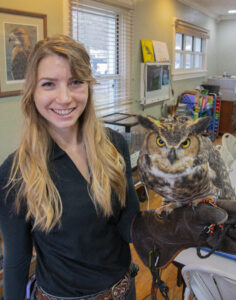

 Martha came to us in 2005 as an adult patient. Her
Martha came to us in 2005 as an adult patient. Her  Chuck arrived at our Wildlife Rehabilitation Center as an adult patient with an injured right wing that prevents his release. While in his enclosure, he enjoys resting high up on his perches and communicating with the local red-tailed hawks who fly above the area. Chuck is an educational ambassador and travels to events and programs to teach the public about red-tailed hawks.
Chuck arrived at our Wildlife Rehabilitation Center as an adult patient with an injured right wing that prevents his release. While in his enclosure, he enjoys resting high up on his perches and communicating with the local red-tailed hawks who fly above the area. Chuck is an educational ambassador and travels to events and programs to teach the public about red-tailed hawks. Ray arrived at our Wildlife Rehabilitation Center in 2002 as an adult patient. His right wing was injured in the wild, preventing him from being released. Ray is an extremely social and eager education ambassador, and even attempts to mimic human voices. Ray enjoys meeting new people and vocalizing his favorite phrase, which sounds roughly like “ssskkwhyyy.”
Ray arrived at our Wildlife Rehabilitation Center in 2002 as an adult patient. His right wing was injured in the wild, preventing him from being released. Ray is an extremely social and eager education ambassador, and even attempts to mimic human voices. Ray enjoys meeting new people and vocalizing his favorite phrase, which sounds roughly like “ssskkwhyyy.”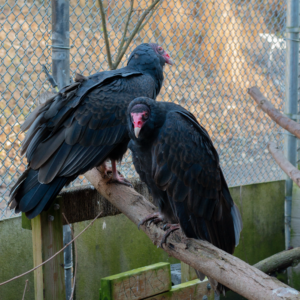
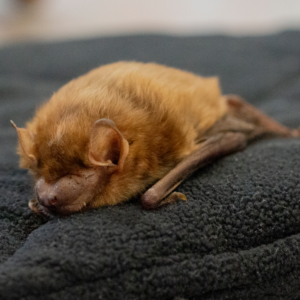

 Amenti came to the Wildlife Center as a patient in 2019, and
Amenti came to the Wildlife Center as a patient in 2019, and 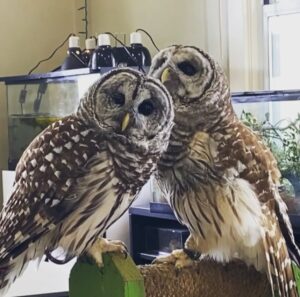 Leela came in as a patient at our Wildlife Rehabilitation Center in fall of 2018. Her right eye is non-functional and prevents her from seeing well enough to pass her flight tests. Cecilia came to us from another rehabilitation center in 2014 as an adult. She had an injured left shoulder that resulted in a full amputation of her wing. Cece and Leela live together and love sharing a perch. In the wild, Barred Owls can hang out in communities and raise their young together.
Leela came in as a patient at our Wildlife Rehabilitation Center in fall of 2018. Her right eye is non-functional and prevents her from seeing well enough to pass her flight tests. Cecilia came to us from another rehabilitation center in 2014 as an adult. She had an injured left shoulder that resulted in a full amputation of her wing. Cece and Leela live together and love sharing a perch. In the wild, Barred Owls can hang out in communities and raise their young together.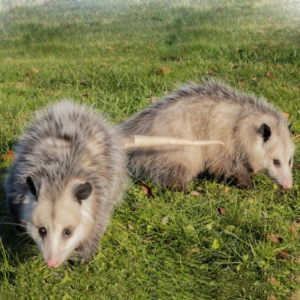 Thelma and Louise came to the Wildlife Center as patients in 2021 as juveniles after a member of the public had kept them, and they became habituated. Opossums often get a bad reputation, but did you know that opossums can eat over 5,000 ticks a year? Thelma and Louise help teach the community that there is a lot more to these creatures than what meets the eye!
Thelma and Louise came to the Wildlife Center as patients in 2021 as juveniles after a member of the public had kept them, and they became habituated. Opossums often get a bad reputation, but did you know that opossums can eat over 5,000 ticks a year? Thelma and Louise help teach the community that there is a lot more to these creatures than what meets the eye!








